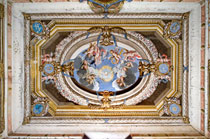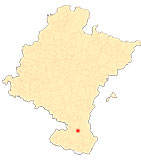Sanctuary of Nuestra Señora del Yugo
By Ricardo Fernández Gracia
The dressing room
The project and design were carried out by the overseer of works of the diocese of Pamplona, Juan Antonio San Juan, and the local masons Pedro Burgui and Bartolomé Peña were in charge of its material execution. The piece was built at church level, as is generally the case in Navarre, and is decorated with fresco paintings from 1728 by José Eleizegui, which constitute one of the most interesting Baroque stage sets in Navarre.
Eleizegui's decoration consisted of frescoes that, like painted canvases, cover the walls of the rectangle with themes alluding to the life of the Virgin - Annunciation, Holy Family and Flight into Egypt, and iconographies of the local patron saints on both sides of the transparent one - St. Stephen and St. Lawrence - and, of course, the passage of the miraculous apparition of the Virgin of the Yoke before the procession of authorities and people who are preparing to pick her up on a litter. The ceiling is the most interesting part of the ensemble, simulating an elliptical roof with the allegories of the litany on the pendentives -moon, cedar, sun and mirror-, the Holy Spirit with angels in the centre surrounded by a garland of flowers and the Lauretan symbols of the Speculum and the Turris. The style of all the paintings reveals his early 18th-century Baroque style plenary session of the Executive Council , although in some compositions, such as Saint Joachim, Saint Anne and the Child Virgin, the memory of Berdusán is evident, although this is understandable if we consider the great production and influence of the style of that master who died thirty years earlier.
-
MUNÁRRIZ, L., El santuario del Yugo, Pamplona, Imprenta y Librería de Joaquín Lorda, 1898.
-
GARCÍA GAÍNZA, M. C. and others, Catalog Monumental de Navarra. I. Merindad de Tudela, Pamplona, Government of Navarre-Archbishopric of Pamplona-University of Navarre, 1980.
-
FERNÁNDEZ-LADREDA, C., Imaginería medieval mariana, Pamplona, Government of Navarre, 1989.
-
FERNÁNDEZ GRACIA, R., "Un aspecto de la arquitectura barroca en Navarra: los camarines", conference proceedings del I congress General de Historia de Navarra. Príncipe de Viana (1988), appendix 11, pp. 149-158.
-
ECHEVERRÍA GOÑI, P. and FERNÁNDEZ GRACIA, R., "La arquitectura religiosa de los siglos XVI al XVIII en Navarra", Ibaiak eta Haranak. Guía del Patrimonio artístico y paisajístico. Navarra, vol. VIII, San Sebastián, Etor, 1991.
-
AZANZA LÓPEZ, J. J., Arquitectura Religiosa Barroca en Navarra, Pamplona, Government of Navarre, 1996.
-
FERNÁNDEZ GRACIA, R., The Baroque altarpiece in Navarre. Pamplona, Government of Navarre, 2003.












